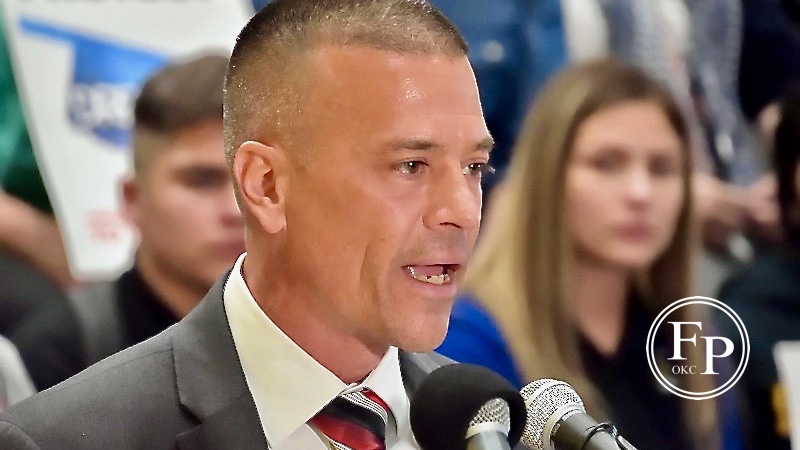Last Updated on December 7, 2019, 10:15 AM | Published: December 6, 2019
Chris Brewster is the founding superintendent of Santa Fe South charter schools in southside Oklahoma City and is blunt in his criticism of the A-F school report card system.
Santa Fe South Schools, Inc. is a charter school network sponsored by Oklahoma City Public Schools.
“If the tool [A-F School Report Card] is designed to tell the public how effective the public school is, then it’s not working,” said Brewster in a phone interview after this year’s state report cards were released.
The system is not taking into account the sometimes radical differences in opportunities from one community to the next he argues.
Oklahoma’s school report card website says, “At the core of the Oklahoma School Report Cards is the belief that all students can grow and all schools can improve.”
But, along with many traditional public school leaders, Brewster criticizes the A-F report card system for not actually measuring student growth over the school year being measured.
Zipcode
Some critics say it only reveals the benefits or liabilities of the zip code the children are living in. Brewster seemed to agree.
“Unless we’re trying to affirm that it was a great idea for white people to move to suburbia … affirming white flight and affirming selective admission process — unless the letter grade is only affirming that practice — then nobody is doing anything about what it’s revealing,” said Brewster. “It’s really insane.”
Referring to the A-F report card system, he said,
“It does not evaluate how good the teachers are in any given building, or how good the leaders are in any given building. All this seems to be doing is identifying low socio-economic communities and providing no solution for schools that work with really under-resourced communities.”
Santa Fe South
The seven Santa Fe South schools, elementary through high school college prep, serve 3,278 students from a part of Oklahoma City where large pockets of poverty and high mobility exist.
Those are two factors any experienced educator will say weighs heavily on any school’s performance overall.
And Brewster sees the stubborn effects of poverty and poor conditions affecting his students the same as traditional neighborhood public schools nearby.
Same curriculum, different grades
Santa Fe South has a unified curriculum meant to provide continuity from elementary through high school, but that does not ensure performance in the ways the A-F report cards measure it.
“My teachers are the same teachers following the same curriculum, working with the same student population,” said Brewster. “But, you have a tool that’s being used to grade them that is an inaccurate tool.”

Some critics of traditional public schools have criticized what they believe are the negative effects of a unionized teacher workforce.
But, Santa Fe South has no such unionized workforce. Teachers are hired and fired as the charter company sees fit and they are expected to follow a unified curriculum.
Yet, performance in the Santa Fe South schools is varied, although not as generally low as surrounding public schools.
- SANTA FE SOUTH EARLY CHILDHOOD = N/A
- SANTA FE SOUTH SPERO ES = B
- SANTA FE S PATHWAYS MID COLLEG = B
- SANTA FE SOUTH HS = D
- SANTA FE SOUTH MS = C
- SANTA FE SOUTH PENN ES = C
- SANTA FE SOUTH HILLS ES = D
“With very few exceptions, we simply have very low academic attainment in our poor communities,” said Brewster. “And, what do we not do about this? There’s no conversation about that. And it doesn’t make any sense to me.”
Selection determines output
What some proponents of charter schools passionately deny, Brewster calmly confirms.
If some students are selected out or self-select, then the overall performance of the school can be somewhat controlled.
“When schools don’t control inputs then the outputs are what they are,” he said. “But, as you control an input, you can have a much higher likelihood of institutional success.”
And, he was careful to give credit to schools that intentionally, clearly are selective, or the students self-select, for a particular set of goals like Harding Charter Prep, Harding Fine Arts, and Classen School for Advanced Studies.
Different kind of selection
But, Santa Fe South schools are selective in a very different way, said Brewster.
“We literally select the hardest group of students to work with through the establishment of our academic enterprise zone.”
“We ensure that students of poverty, students with minority status, and students generally from first-generation immigrant families receive a priority into our school.”
The charter’s goals produce a selection process that puts their teachers and administrators to work with the most demanding kids to teach because of poverty or other harsh life circumstances.
A-F Report Cards
Oklahoma implemented the A-F School Report Card system in 2011 after the Republican Party gained control of both houses of the Legislature in the 2010 elections.
The original language and concepts used were patterned after former President George W. Bush’s “No Child Left Behind” initiative at the national level.
The report cards were intended to show parents, educators, and taxpayers which schools were performing well and which were not creating accountability.
But, the metrics and methods have been in doubt from the beginning primarily because the measurement does not show the growth of students over the school year being measured.
Updated: Dec. 7, 2019. 10:14 a.m.
Founder, publisher, and editor of Oklahoma City Free Press. Brett continues to contribute reports and photography to this site as he runs the business.









